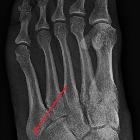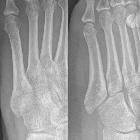avulsion fracture of the 5th metatarsal styloid





















Avulsion fracture of the 5 metatarsal styloid, also known as a pseudo-Jones fracture or a dancer fracture, is one of the more common foot avulsion injuries and accounts for over 90% of fractures of the base of the 5 metatarsal.
Despite what should be a simple entity, controversy exists, as well as confusion in the literature, with the term Jones fracture sometimes liberally (and incorrectly) applied to this fracture.
Pathology
Traditionally this avulsion fracture has been ascribed to the insertion of peroneus brevis and is caused by forcible inversion of the foot in plantar flexion, as may occur while stepping on a curb or climbing steps. It is for this reason that the 5metatarsal base must be included in the lateral ankle projection of an ankle series, especially when performed for an inversion injury.
It is also relatively common among tennis players, accounting for it sometimes being referred to as a "tennis fracture".
Some authors believe that it is due to the lateral cord of the plantar aponeurosis which also inserts at the base, rather than the peroneus brevis tendon .
Radiographic features
Small fracture usually of the tuberosity of the proximal 5 metatarsal, oriented mostly transversely (cf. apophysis which parallels the shaft). It usually does not reach the tarsometatarsal (metatarsocuboid) joint, but occasionally does.
In some instances, the fracture may be occult.
Treatment and prognosis
In general, these fractures can be treated conservatively, and heal well . For large or very displaced fragments with intra-articular extension then operative fixation may be indicated.
Differential diagnosis
A number of fractures occur at the base of the 5 metatarsal (see fractures of the proximal fifth metatarsal) as well as entities that mimic fractures:
- Jones fracture: at the metaphysis-diaphysis junction, at the level of the fourth-fifth intermetatarsal articulation
- stress fracture of the 5metatarsal: at the proximal diaphysis, distal to the level of the fourth-fifth intermetatarsal articulation
- os peroneum
- os vesalianum
- normal apophysis of the proximal 5 metatarsal
Siehe auch:
- normale Apophyse proximal am Os metatarsale 5
- Os peroneum
- Avulsionsfraktur
- proximale Frakturen Os metatarsale 5
- Jones-Fraktur
- Apophysitis an der Basis des Os metatarsale 5 (Iselin-Krankheit)
- Stressfraktur 5. Mittelfußknochen
und weiter:

 Assoziationen und Differentialdiagnosen zu Avulsionsfraktur Basis Metatarsale 5:
Assoziationen und Differentialdiagnosen zu Avulsionsfraktur Basis Metatarsale 5:





